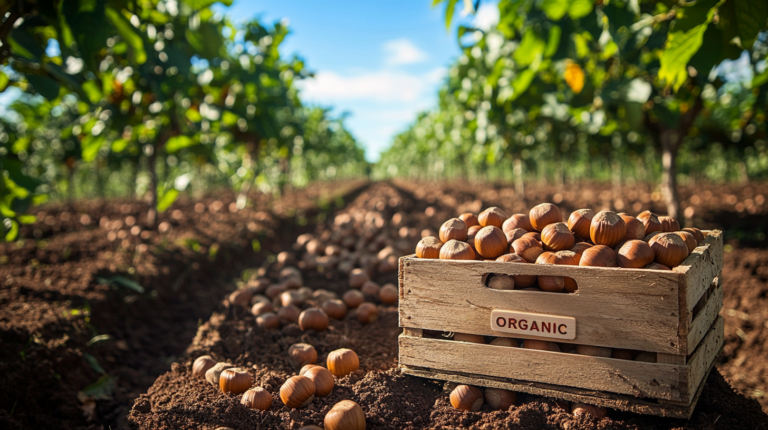Analyzing the Impact of Weather on Hazelnut Prices
The price of hazelnuts is influenced by various factors, including weather conditions, which can significantly impact production and, consequently, market prices. Here’s a detailed analysis based on the provided sources:
Historical Price Trends
US Hazelnut Prices
- 2022: $1300 per metric ton, down from $2160 in 2021, a decrease of 39.81%[1].
- 2021: $2160 per metric ton.
- 2020: $2100 per metric ton.
- 2019: $1920 per metric ton.
- 2018: $1800 per metric ton.
- 2017: $2300 per metric ton.
- 2016: $2700 per metric ton.
- 2015: $2800 per metric ton.
- 2014: $3600 per metric ton.
Export Prices
- 2022: $5.07 per kg.
- 2021: $5.10 per kg.
- 2020: $4.55 per kg.
- 2019: $4.04 per kg.
- 2018: $3.59 per kg.
- 2017: $3.72 per kg[2].
Weather Impact on Production
US Production
- Oregon’s Willamette Valley: Produces 99% of North American hazelnuts. The region’s moderate climate is crucial for reliable hazelnut crops[5].
- Climate Challenges: Increased instances of drought, extreme precipitation, and reduced summer precipitation can impact productivity. For example, an ice storm in February 2021 severely impacted many orchards, though they rebounded[5].
Turkish Production
- 2022/23 Forecast: 765,287 tonnes, a 12% increase year-on-year despite sub-zero conditions in March 2022[3].
- Weather Events: High-altitude areas experienced sub-zero temperatures, but the overall impact was minimal due to favorable conditions later in the season[3].
Correlation Analysis
Price Fluctuations and Weather Events
- 2022 Price Drop: The significant price drop from $2160 to $1300 per metric ton in the US could be attributed to various factors, including potential overproduction or reduced demand. However, weather events like the 2021 ice storm in Oregon likely contributed to supply disruptions, affecting prices[1][5].
- Turkish Production Increase: Despite adverse weather conditions in March 2022, Turkey’s production forecast increased by 12%, indicating that favorable weather conditions later mitigated early damages. This stability in production likely helped maintain or reduce price volatility[3].
Long-Term Trends
- US Prices: The historical data shows significant fluctuations, with prices peaking in 2014 at $3600 per metric ton and experiencing a general decline since then. This trend suggests that while weather events impact short-term prices, other factors like market demand, global production levels, and economic conditions also play crucial roles[1].
- Export Prices: The export prices have shown a steady increase over the years, peaking in 2021. The slight decline in 2022 could be due to increased global production, including Turkey’s higher forecast, which would increase supply and potentially lower prices[2].
How do weather patterns influence hazelnut yield?
Weather patterns and climate conditions play a crucial role in influencing hazelnut yield. Based on the provided search results, here’s an analysis of how various weather factors impact hazelnut production:
Temperature
- Hazelnut trees require adequate winter chill (around 800-1600 hours depending on the cultivar) to break dormancy and ensure proper flowering and nut set. Warmer winters with insufficient chill hours can negatively impact yields.
- Higher temperatures during flowering can lead to earlier phenological stages, shorter flowering duration, poor pollen viability, and reduced fruit set. This can result in lower yields.
- Extremely high temperatures during the nut development stage can cause sunburn damage and reduce nut quality.
Precipitation
- Adequate soil moisture, especially during the nut-fill period (mid-December to March), is crucial as hazelnut trees are not drought-tolerant. Insufficient rainfall or drought conditions can severely impact yields.
- However, excessive rainfall during flowering can hinder pollination and reduce fruit set.
- The timing of precipitation is also important, with rainfall deficits during critical growth stages having a more significant impact on yields.
Other Factors
- High humidity levels during flowering can promote fungal diseases, affecting pollination and fruit set.
- Strong winds during flowering can disrupt pollination and reduce yields.
- Frost events during bud break or flowering can damage flowers and young nuts, leading to yield losses.
Regional Impacts
- In the US, particularly Oregon’s Willamette Valley (which produces 99% of North American hazelnuts), increased instances of drought, extreme precipitation events, and reduced summer precipitation can negatively impact productivity.
- In Turkey, a major hazelnut producer, sub-zero temperatures in early spring can damage flowers and young nuts, but favorable conditions later in the season can mitigate the impact.
- Climate change is projected to shift suitable hazelnut growing regions, with some areas becoming unsuitable while others at higher altitudes may become viable.
In summary, weather patterns significantly influence hazelnut yields through their effects on critical phenological stages, such as flowering, pollination, and nut development. Factors like temperature, precipitation, humidity, frost, and wind play crucial roles, and their impacts can vary regionally based on local climate conditions. Proper management practices and adaptation strategies are essential to mitigate the effects of adverse weather events and climate change on hazelnut production.
What are the most significant weather events that impact hazelnut prices?
Weather events play a crucial role in determining hazelnut yields, which in turn significantly influence market prices. Here are the most significant weather events that impact hazelnut prices, based on the provided sources:
1. Cold Spells and Frost
- Impact on Yield: Cold spells, especially during the flowering and early nut development stages, can cause significant damage to hazelnut crops. Frost can kill flowers and young nuts, leading to reduced yields.
- Economic Consequences: Predicting cold spells a few weeks in advance can allow farmers to take protective measures, such as covering plants or using anti-frost turbines, which can mitigate losses. This predictive capability can also help buyers and sellers make informed economic decisions, potentially stabilizing prices.
2. Heat Waves
- Impact on Yield: Hazelnut trees are sensitive to excessive heat, particularly during the nut development stage. High temperatures can cause sunburn on nuts and reduce their quality. Prolonged heat waves can also stress the trees, leading to lower yields.
- Economic Consequences: Heat waves can lead to a decrease in supply, driving up prices. For instance, climate change-induced heat waves in Turkey’s Black Sea region have led to declines in crop yields, affecting global supply and prices.
3. Drought
- Impact on Yield: Hazelnut trees require adequate soil moisture, especially during the nut-fill period. Drought conditions can severely impact yields by stressing the trees and reducing nut size and quality.
- Economic Consequences: Droughts can lead to significant reductions in hazelnut production, causing supply shortages and price increases. For example, reduced summer precipitation in Oregon’s Willamette Valley, a major hazelnut-producing region, can negatively impact productivity and drive up prices.
4. Excessive Rainfall
- Impact on Yield: While hazelnut trees need sufficient rainfall, excessive precipitation, especially during the flowering period, can hinder pollination and reduce fruit set. Waterlogged soils can also lead to root diseases and other issues.
- Economic Consequences: Excessive rainfall can disrupt production and lead to lower yields, contributing to supply shortages and higher prices. For instance, increased rainfall during critical growth stages can negatively affect yields and market dynamics.
5. Wind
- Impact on Yield: Strong winds can damage hazelnut trees, especially during the flowering and early nut development stages. Wind can also cause physical damage to the nuts and trees, leading to reduced yields.
- Economic Consequences: Wind damage can lead to lower yields and reduced quality, impacting supply and driving up prices. Windbreaks are often required to protect hazelnut orchards from such damage.
Regional Examples
- Turkey: As the world’s largest hazelnut producer, Turkey’s coastal areas facing the Black Sea are particularly vulnerable to cold spells and heat waves. These weather events can have a global impact on hazelnut prices due to Turkey’s significant contribution to the global supply.
- Oregon, USA: The Willamette Valley, which produces 99% of North American hazelnuts, is susceptible to drought and extreme precipitation events. These weather conditions can significantly impact local production and influence prices in the US market.
Conclusion
Weather conditions have a significant impact on hazelnut production and prices. Adverse weather events, such as cold spells, heat waves, drought, excessive rainfall, and frost, can disrupt critical phenological stages like flowering, pollination, and nut development, leading to yield losses and price volatility. These impacts can vary regionally based on local climate conditions. While weather events can cause short-term price fluctuations, long-term trends are shaped by a combination of factors, including global production levels and economic dynamics. Proper management practices and adaptation strategies are essential to mitigate the effects of adverse weather events and climate change on hazelnut production. Understanding and predicting these weather patterns can help stakeholders in the hazelnut industry make informed economic decisions, potentially stabilizing prices and ensuring a more reliable supply.
References
- YCharts
- Selina Wamucii
- Mintec Global
- REACCH
- Climate Hubs USDA
- Procurement Resource
- Commodity Board
- NCBI
- MDPI – Agriculture
- UTAD Repository
- MDPI – Horticulturae
- Science Direct
- World Wildlife Fund
- CMCC
- Cardassilaris
- Mundus Agri
- Climate Europe






